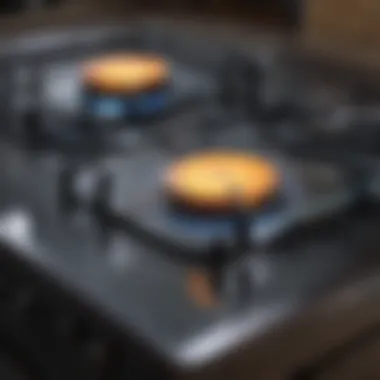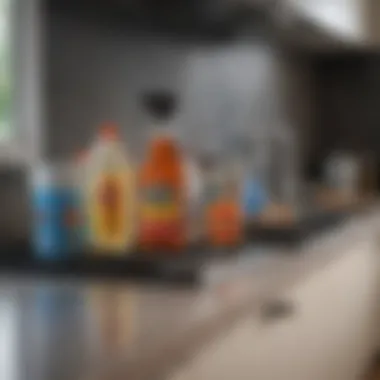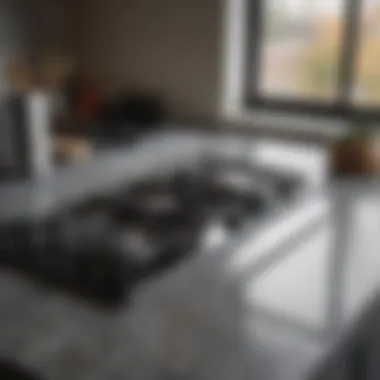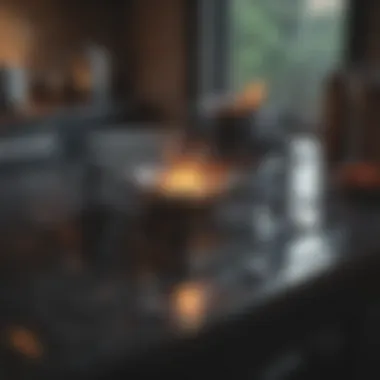Expert Tips for Cleaning Your Glass Top Stove


Intro
Cleaning a glass top stove requires a focused strategy to preserve its sleek look and functionality. The surface is well-known for its modern appearance, but it can present unique challenges when it comes to maintenance. This guide aims to navigate the variety of cleaning methods, materials, and techniques optimal for glass top stoves. By understanding these details, homeowners can ensure that their appliances shine brightly while remaining efficient in use.
Design Inspiration
When considering your kitchen aesthetics, the appearance of your glass top stove plays a significant role. This choice reflects modern design trends and influences the overall kitchen style. It is essential to think about how your stove fits into the broader kitchen environment.
Trending Styles
Glass top stoves come in various designs that align with contemporary kitchen fashion. Their sleek and minimalist appearance works well in any high-end or modern kitchen. Some popular styles include:
- Frameless Designs: These give the impression of a seamless surface, contributing to a clean look.
- Integrated Features: Models that blend controls seamlessly enhance usability without detracting from design.
Color Palettes
A diverse array of color options can complement the overall color scheme of your kitchen. While black and white are classic choices, you can also find stoves in vibrant colors like red or blue, each adding their unique touch. Selecting the right color can help elevate the kitchen's visual appeal.
Practical Tips
Maintaining the luster and efficiency of your glass top stove requires regular attention. This section discusses effective cleaning methods and care tips.
Maintenance & Care
Regular upkeep is crucial to avoid scratches and stains on your stove's surface. Here are some effective maintenance tips:
- Use Soft Cloths: Only employ soft materials to avoid scratching the surface.
- Avoid Harsh Chemicals: Choose cleaners specifically designed for glass cooktops.
"Regular cleaning prevents residue build-up, which could affect cooking performance and aesthetics."
- Wipe Spills Immediately: This helps prevent stains and burnt-on food.
Budgeting & Planning
Cleaning does not need to be an expensive endeavor. Here are some budgeting tips:
- Homemade Cleaners: Solutions made from vinegar or baking soda can be effective and cost-efficient.
- Bulk Buying: Purchasing cleaning supplies in bulk can save money long-term.
Prelude to Glass Top Stoves
Cleaning and maintaining a glass top stove is essential for ensuring its longevity and effectiveness. The complexity of these appliances often leads to a multitude of questions about their care. A glass top stove can add a sleek aesthetic to any kitchen, but it also requires diligent maintenance to keep it looking and performing at its best. This section will provide a foundational understanding of glass top stoves, elucidating their design and common issues that may arise during usage.
Understanding Glass Top Stoves
Glass top stoves, often constructed with ceramic glass, are popular for their modern appearance and ease of cleaning. Unlike traditional stovetops, they offer a smooth surface, which allows for seamless integration with kitchen counters and enhances overall visual appeal. They can utilize radiant or induction heating methods, making them both functional and efficient. The even heating capabilities often contribute to better cooking results, appealing to both casual cooks and culinary enthusiasts alike.
However, it is important to note that glass surfaces can be susceptible to scratching and staining if not properly cared for. Simple awareness about the design and functionality of these stoves can dramatically improve the way one operates and maintains their appliance.
Common Issues with Glass Top Stoves
Despite their many advantages, glass top stoves can present various challenges to users, particularly when it comes to cleaning and maintenance. Some of the most frequent problems include:
- Scratches and Scuffs: Foreign objects or abrasive materials can scratch the glass, compromising appearance and functionality.
- Stains from Food Spillages: Sugary substances, oils, and other kitchen ingredients can leave stubborn marks if not cleaned promptly.
- Buildup of Residue: Over time, grime and debris can accumulate, diminishing the stovetop's efficiency and aesthetic appeal.


Understanding these common issues leads to more effective cleaning strategies. Awareness of the potential pitfalls allows homeowners to take preventive measures, ensuring their glass top stove remains a pivotal piece in their kitchen. By approaching maintenance proactively, one can enjoy the benefits of a clean, efficient, and visually appealing cooking surface.
The Importance of Regular Cleaning
Regular cleaning of your glass top stove is essential for several reasons. The functionality, safety, and appearance of the stove can significantly benefit from consistent maintenance. If not cleaned regularly, stains and grime can accumulate, leading to potential long-term damage. The process of cleaning not only refreshes the surface but also promotes better cooking performance.
Preventing Stains and Buildup
One of the key advantages of regular cleaning is the prevention of stains and buildup. Cooking spills can turn into tough stains if left unattended. For instance, burnt food can harden and adhere to the stove surface, making it more challenging to remove later. By establishing a routine cleaning schedule, these stubborn remnants can be managed effectively before they become a nuisance. Using a mild cleaner after each use can help maintain the surface in a pristine condition, allowing for easy wipe-downs and preventing the need for extensive scrubbing later on.
Maintaining Efficiency
A clean stove is a efficient stove. Residue and debris can affect how evenly the surface heats, which can alter cooking times and the quality of the meals prepared. If grime accumulates, it can act as an insulation layer, reducing heat transfer and leading to longer cooking times. Regular maintenance ensures that heat distribution remains optimal, thereby enhancing overall cooking efficiency. When the stove performs well, it contributes to better energy consumption, which is not only cost-effective but also environmentally responsible.
Aesthetic Considerations
Lastly, the aesthetic value of a clean glass top stove cannot be understated. The kitchen is often the focal point of a home, and a dirty stove can detract from its overall appeal. Regular cleaning helps maintain the clear and shiny surface that glass cooktops are known for. It signals attention to detail and care for one’s home environment. A clean stove complements the kitchen’s appearance, reflecting a homeowner's commitment to maintenance and design.
"Regular cleaning not only enhances functionality but also preserves the beauty of your kitchen space."
Essential Cleaning Supplies
Cleaning a glass top stove requires specific supplies that ensure effectiveness while protecting the surface. The right products and tools not only help maintain the stove's appearance but also prolong its lifespan and efficiency. When selecting essential cleaning supplies, it is crucial to consider their compatibility with glass surfaces. Using harsh or abrasive materials can lead to scratches or damage.
A proper cleaning arsenal includes a few recommended cleaning products as well as tools tailored for effective cleaning. This combination enables homeowners to tackle stains and buildup effectively.
Recommended Cleaning Products
Choosing the right cleaning solutions is key to achieving a spotless glass top stove. Here are some widely recommended products:
- Glass stove cleaner: Formulated specifically for glass stove tops, these cleaners dissolve grease and food particles without scratching.
- Vinegar: A natural option that works well for light cleaning and is safe for most glass surfaces.
- Baking soda: This ingredient is effective for tackling tough stains when used as a paste.
These products can simplify the cleaning process while ensuring that the surface remains shiny and clear.
Tools for Effective Cleaning
The tools used for cleaning are just as important as the cleaning products themselves. Specific tools can enhance the results. Here are some essential tools:
Non-abrasive Scrapers
Non-abrasive scrapers are a crucial tool for removing stubborn residues from glass top stoves. They are specially designed to prevent scratches. A well-made scraper has a flat blade that glides over the surface, ensuring a thorough clean without damage. Additionally, they are easy to handle, making them efficient in scraping away burnt-on food without requiring excessive force. This leads to a safer and more effective cleaning experience.
Microfiber Cloths
Microfiber cloths are effective for wiping down and polishing glass surfaces. Their unique construction allows them to absorb dirt and grime effectively from glass tops. Importantly, they do not leave lint or streaks behind, ensuring a clear finish after cleaning. Microfiber cloths are also machine washable, making them economical and sustainable. They are a beneficial choice for regular maintenance as they are gentle while providing thorough cleaning.
Soft Brushes
Soft brushes offer another layer of cleaning efficiency. They can reach corners and edges that might be inaccessible with cloths or scrapers. Their bristles are gentle enough to avoid scratching yet firm enough to dislodge dirt and debris. Soft brushes excel in removing particles without damaging the surface. Additionally, they can help in applying cleaning solutions evenly across the stove top, ensuring thorough cleansing.
"Using the right cleaning supplies can turn a tedious chore into a simple task while preserving the quality of your glass top stove."
Ultimately, selecting effective cleaning products and tools is vital for maintaining a glass top stove. Proper cleaning supplies enhance the performance and longevity of this kitchen appliance, ensuring that it remains an attractive and functional part of the home.
Step-by-Step Cleaning Process


Cleaning a glass top stove properly involves a methodical approach. This process is essential because it ensures that every part of the stove is addressed, avoiding any missed areas that could lead to residual dirt or stuck-on food. A systematic cleaning method not only enhances the appearance of the stove but also preserves its functionality. Neglecting proper cleaning can result in permanent stains or scratches, which can diminish the overall value of your kitchen appliance.
Preparation of the Surface
Before starting the cleaning process, it is crucial to prepare the surface of the glass top stove. This involves ensuring the stove is cool to the touch to prevent burns. It is advisable to remove any loose debris or food particles from the surface. A soft brush or a dry microfiber cloth can effectively clear away crumbs or dust. This initial preparation sets the stage for a more in-depth cleaning and helps avoid scratching the surface later on.
Application of Cleaning Solution
Once the surface is prepared, it is time to apply the cleaning solution. Select a cleaning product specifically formulated for glass top surfaces. Spray the solution evenly across the stove, ensuring to cover all areas with a fine mist. Allow the solution to sit for a few minutes; this dwell time enables the cleaner to break down tough stains and grease. Utilizing a solution that is safe and effective will yield better results and will not damage the glass surface.
Scrubbing Techniques
Gentle Circular Motions
Gentle circular motions serve as an effective scrubbing technique for glass top stoves. This approach promotes even distribution of pressure on the surface, minimizing the risk of scratches. The key characteristic of this method is its non-invasive nature, where it cleans and lifts stains without harming the glass. The unique feature of gentle circular motions is that it allows for thorough cleaning by reaching crevices without aggressive scrubbing, which can cause micro-abrasions. Its primary advantage in this context lies in its balance of cleaning power without compromising the glass integrity.
Focusing on Stains
Focusing on stains is another critical aspect of the scrubbing process. This technique involves identifying the more stubborn spots and dedicating extra effort to eliminate them. The key characteristic of this method is its targeted approach. Addressing stains on a one-by-one basis tends to be more effective than an overall scrub. The unique feature of focusing on stains is that it can involve slightly more pressure or a specialized tool to lift tougher residues. While it may require more time and effort, the advantage is clear: effectively treating the toughest spots ensures a perfectly clean finish.
Final Wipe Down
After scrubbing, a final wipe down is essential to remove any remaining cleaning solution and residue. Use a clean, damp microfiber cloth to carefully wipe the surface. This action not only removes the cleaning solution but also helps to shine the glass. Ensure to do a final pass with a dry cloth for an added layer of gloss. This step is significant as it gives a polished look, enhancing the overall aesthetics of the glass top stove. Completing this step guarantees that the cleaning process leaves no streaks or marks behind, resulting in a crystal-clear surface.
Dealing with Stubborn Stains
Stubborn stains on a glass top stove can be a major frustration for homeowners. These stains not only impact the appearance of your appliance but can also affect its efficiency. Cleaning such stains requires a methodical approach. Ignoring them may lead to buildup, making future cleaning more difficult and time-consuming. Thus, knowing how to effectively deal with stubborn stains is imperative for maintaining both the functionality and the aesthetics of your glass top stove.
Identifying Stubborn Stains
Stains may originate from various sources. Spills from boiling over liquids, food residue, and even burnt-on debris can create marks. Understanding which stains are difficult to remove is the first step. Look for:
- Burnt food or residue - often blackened and caked onto the surface.
- Hard water stains - typically leave a cloudy or streaky appearance.
- Crayon or wax stains - these can be particularly challenging as they tend to melt into the glass.
Identifying these stains allows you to choose the right cleaning approach effectively.
Special Techniques for Tough Stains
When regular cleaning solutions don't suffice, specialized methods can help tackle tough stains. Here are two effective techniques:
Using Baking Soda
Baking soda is a common household item that offers various benefits for stain removal. Its key characteristic is its mild abrasiveness. This feature enables it to gently scrub surfaces without scratching the glass. When mixed with a small amount of water to form a paste, it becomes a powerful stain remover. The granular texture helps to lift burnt food particles and debris, making it a popular choice for many homeowners.
However, it's essential to be cautious. Too much pressure can still scratch the surface, so use it sparingly. Additionally, while baking soda is generally safe, it can create a mess if not rinsed properly after cleaning.
Utilizing Vinegar
Vinegar is another versatile cleaning agent known for its effectiveness against tough stains. Its acidity allows it to dissolve mineral deposits and grease. When applied directly, vinegar can break down and loosen the stubborn particles that cling to your stove.
The unique feature of vinegar is its ability to cut through grime while being non-toxic. This makes it a safe choice for household cleaning. However, be aware that using vinegar frequently may lead to a lingering scent, which some may find unpleasant. Therefore, consider using it alongside other methods for best results.
The combination of baking soda and vinegar can create a powerful solution when tackling stubborn stains on glass top stoves. Applying them correctly can yield impressive results.


Understanding how to identify and tackle stubborn stains effectively enhances your cleaning approach, ensuring your glass top stove looks pristine for longer.
Preventing Future Stains
Preventing future stains on your glass top stove is an essential aspect of its overall maintenance. Stains can lead to more significant cleaning challenges over time, affecting not just the appearance but also the function of the stove. Regular prevention can save time and effort in the long run, keeping your stove looking pristine and functioning efficiently.
Choosing the Right Cookware
The importance of cookware cannot be overstated when considering stain prevention. Using the right pots and pans can make a notable difference in keeping your glass top stove clean. Cookware materials such as stainless steel, anodized aluminum, and ceramic are less likely to scratch and do not create residue that can stick to the surface.
- Avoid glass or ceramic cookware that has a rough bottom. Its surface can easily scratch the glass top.
- Use flat-bottomed pans. They maximize contact with the stove and reduce the chances of spills or food being trapped in crevices.
- Be cautious with heavy cookware. Dropping a heavy pot can cause cracks or chips.
Implementing Cooking Practices
Besides the choice of cookware, certain cooking practices can also help in minimizing stains. By changing how you cook, you can maintain your stove's condition much better.
- Control the heat. Using high heat can cause food to splatter more, leading to stubborn stains. Medium heat often suffices and can help in minimizing residue.
- Clean as you go. Wipe up spills immediately after they occur. If you allow them to dry, they become more challenging to remove.
- Keep lids on pots. This helps prevent spills and boiling over, reducing the chances of mess on the surface.
"Regular care is more effective than periodic deep cleaning. By making small adjustments in your cookware choices and cooking habits, you preserve the appearance and efficiency of your glass top stove."
Following these guidelines will help prevent future stains, ensuring you can maintain a clean and efficient cooking surface.
Maintenance Tips for Longevity
Maintaining a glass top stove is essential for its durability and consistent performance. The surface can easily become scratched or stained if not treated with care. A proactive approach in maintaining your stove contributes significantly to its longevity. By establishing effective practices and routines, you can prevent damage and ensure that the appliance continues to function efficiently.
Setting a Cleaning Schedule
Establishing a regular cleaning schedule is vital for preventing grime buildup on a glass top stove. Ideally, you should clean the surface after every use. This prevents residue from hardening and becoming more challenging to remove later. Ensure that spills are wiped away promptly. This not only keeps the surface cleaner but also helps maintain the equipment’s aesthetic appeal.
To create an effective cleaning schedule, consider the following tips:
- Frequency: Daily cleaning after each cooking session, and a more thorough clean weekly.
- Time: Allocate a specific time for cleaning after meals.
- Reminders: Use calendar alerts or sticky notes as reminders for deep cleaning days.
Safe Usage Practices
Using a glass top stove safely is equally important to its maintenance and longevity. Following safe practices not only protects your stove but can also extend its life. Here are a few critical tips:
- Use the right cookware: Select pots and pans with smooth bottoms. Avoid using any cookware made from rough materials that can scratch the glass.
- Avoid dragging pots: Always lift cookware when moving it. Dragging can scratch the surface.
- Temperature control: Gradually heat your stove rather than starting on high. Rapid temperature changes can cause cracks.
- Handle with care: Be cautious with heavy items around the stove to prevent accidents and potential damage.
"Prevention is the most effective strategy when it comes to maintaining glass top stoves. Careful usage goes a long way in lengthening their lifespan."
By incorporating these maintenance tips into your routine, you can ensure that your glass top stove remains a centerpiece of your kitchen, both in functionality and appearance.
Closure
In this article, maintaining a glass top stove has been explored in detail, focusing on the importance of regular cleaning and proper care. Understanding the best practices ensures that homeowners can preserve the appearance and efficiency of their kitchen equipment. The glass top stove is not only a functional appliance but also contributes significantly to the overall aesthetic of a modern kitchen. When kept clean, it becomes a focal point offering both beauty and practicality.
Recap of Best Practices
To achieve optimal results in cleaning a glass top stove, several practices stand out:
- Regular Cleaning: Establish a routine that involves cleaning the surface after each use. This helps to prevent stains from setting.
- Use Non-Abrasive Tools: Non-abrasive scrapers, microfiber cloths, and soft brushes are essential. They prevent scratches while effectively removing dirt and grease.
- Proper Cleaning Products: Choose cleaning agents specifically formulated for glass tops. Avoid harsh chemicals that can damage the surface.
- Stain Prevention: Selecting the right cookware can prevent scratches and stains. Avoid cookware with rough bottoms during cooking.
- Immediate Cleanup: Tackling spills immediately minimizes the risk of tough stains in the future.
Following these practices can greatly enhance appliance longevity and appearance.
Final Thoughts on Maintaining a Glass Top Stove
Taking care of a glass top stove is a worthwhile endeavor. It maintains the functionality and aesthetic quality of an essential kitchen device. Homeowners should prioritize safe usage practices as well. This includes following manufacturer's instructions when using cooking utensils on the surface. Plus, awareness of the stove's temperature can avoid unnecessary wear and tear.
In summary, a keen approach to cleaning and maintenance ensures a glass top stove remains an elegant and efficient choice in any kitchen. Investing time in its care leads to long-lasting results, making the cooking experience more pleasant and visually appealing.















